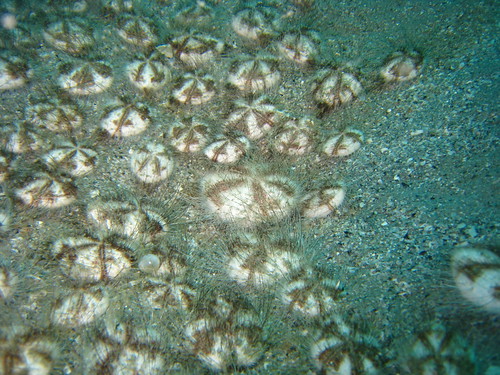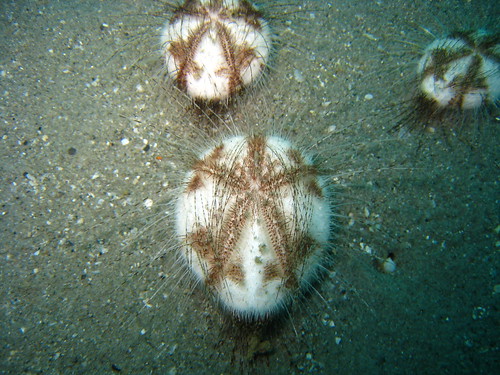 In 2009 (Sometimes even I can't believe how long I've been writing this blog!), I wrote a post that illustrated the results of my published papers. Most people may or may not realize that I'm an active scientist who works on the evolution and diversity of asteroids (aka starfish or sea stars). And even when I tell them.. most folks don't really SEE what it is that I've done.
In 2009 (Sometimes even I can't believe how long I've been writing this blog!), I wrote a post that illustrated the results of my published papers. Most people may or may not realize that I'm an active scientist who works on the evolution and diversity of asteroids (aka starfish or sea stars). And even when I tell them.. most folks don't really SEE what it is that I've done.Part of my research involves TAXONOMY. The description and classification of different species. Biologists who are specialists in taxonomy are present for all organismal groups-from folks who work on protists and fungi to insects, parasitic worms, dinosaurs and the list goes on.
Sadly, the ranks of scientists who practice any kind of taxonomy is shrinking. Why? There are a multitude of reasons that have been offered...
-the need to work on research that secures larger funding sources
-the lack of universities that continue to teach organismal coursework
-the absence of perceived importance of taxonomic research
-changes in the basic pace and emphases of evolutionary research..
All of which go hand-in-hand with the so-called Great Biodiversity Crisis. Essentially the combination of a perceived "happening right now" extinction coinciding with a steady decline of workers who can describe and list how many species exist on Earth. A nice write up by my colleage Craig McClain from Deep-Sea News in Wired on this subject can be found here.
In my case-I am one of the few remaining, world specialists who work on starfish. The number of people who ID sea stars at my level can literally be counted on one hand.
In the time since I've started my professional career, I've described (as of Sept. 2014) aroudn 30 new species (plus some new genera), I have about 3 dozen publications and I oversee the World Asteroidea Database.
Most of these are present in the Goniasteridae-one of the most diverse groups in the Asteroidea and thankfully, a group that I know a thing or two about.....
What I hope to accomplish here is to give some substance to my accomplishments and a tangible sense (limited by the fact that they are pictures of course!) of what diversity remains to be found. And what sorts of animals have been described only in the last few years!
And many more remain to be discovered..
Some various miscellany that you may notice.. So some answers to anticipated questions..
Yes. I do occasionally name species to honor people who have supported or contributed to echinoderm research.
No. I wouldn't name a species after myself. That's considered poor form within the profession...
Here is a "yearbook" of the many new species I've described...Its still incomplete and I will be constantly updating..
2015
UPDATE: February 2015. A new species of the coral predator Evoplosoma from the Atlantic, described in Marine Biodiversity Records.
Blog is here.
2014 (up to 25 species as of June!)
UPDATE: June 2014 Three new species of Hippasteria in the Zoological Journal of the Linnaean Society.
Blog is here.
Hippasteria muscipula from the tropical Pacific
Hippasteria tiburoni from Pioneer Seamount
Hippasteria mcknighti from New Zealand
May 2014 Two new genera and species of Poraniidae in the journal Zootaxa! The blog post is here.
Here is Clavaporania fitchorum from about 1600 m south of Macquarie Island
And from Davidson Seamount off central California- Bathyporania ascendens!
2011
Two Antarctic species! Both of these were named in a recent paper 2011 issue of Zoosystema 2759: 1-48
Chitonaster trangae named for Trang Nguyen at Oregon State University! A dedicated worker that previously worked for the US Antarctic Research Program!
 And a new genus and species- Eratosaster jennae, named for Jen Hammock the administrator of the USARP program who now works for the Encyclopedia of Life..
And a new genus and species- Eratosaster jennae, named for Jen Hammock the administrator of the USARP program who now works for the Encyclopedia of Life..
2010
Sthenaster emmae which I described in 2010 in the Zoological Journal of the Linnean Society
 This deep-sea beast was described from the Tropical Atlantic. Named for Dr. Emma Bullock, a meteoritical geologist in the NMNH Mineralogy Dept.
This deep-sea beast was described from the Tropical Atlantic. Named for Dr. Emma Bullock, a meteoritical geologist in the NMNH Mineralogy Dept.One of the more rarely-encountered species I've described-the very spiny Evoplosoma claguei
 A North Pacific deep-sea coral-predator that is named for Dr. Dave Clague, a geologist working for the Monterey Bay Aquarium Research Institute! This species was featured in an MBARI video on coral-devouring sea stars...
A North Pacific deep-sea coral-predator that is named for Dr. Dave Clague, a geologist working for the Monterey Bay Aquarium Research Institute! This species was featured in an MBARI video on coral-devouring sea stars...
2007
From my 2008 paper....a new genus and species of pentagonasterine goniasterid from New Caledonia.... Akelbaster novacaledoniae !

 From the same paper, a new genus and species of goniasterid from the Ryukyu Islands in Japan:
From the same paper, a new genus and species of goniasterid from the Ryukyu Islands in Japan:
Ryukuaster onnae !

 From that same paper of mine in 2007 is a new species from New Caledonia of the genus Eknomiaster-Eknomiaster beccae. Named for my colleague Becca Price at the University of Washington.
From that same paper of mine in 2007 is a new species from New Caledonia of the genus Eknomiaster-Eknomiaster beccae. Named for my colleague Becca Price at the University of Washington.
 Look! Its got some fun pedicellariae surprises on the underside!
Look! Its got some fun pedicellariae surprises on the underside!

2006
Xyloplax janetae! From Invertebrate Biology 125(2): 136–153.
Circeaster arandae Fr. deep-sea in the Indian Ocean from my 2006 paper in the French journal Zoosystema (28)4:917-954
Circeaster loisetteae from the Solomon Islands..
Circeaster sandrae Fr. the central-South Pacific..
 This species occurs in the deep-seas around New Caledonia and is named after my colleague Dr. Sandra Brooke!
This species occurs in the deep-seas around New Caledonia and is named after my colleague Dr. Sandra Brooke!
There were others from this paper ....
2005
From my 2005 paper reviewing two genera of goniasterid starfish from the tropical Pacific: Glyphodiscus magnificus and...Glyphodiscus pentagonalis
and...Glyphodiscus pentagonalis

and this wonderful beast, Iconaster vanuatuensis
2003
The first new genus and species I ever described!! From a paper I wrote in 2003: a new genus and species of Oreasteridae from the subreef zone:
Astrosarkus idipii from Palau and the southern Indian Ocean

From my 2008 paper....a new genus and species of pentagonasterine goniasterid from New Caledonia.... Akelbaster novacaledoniae !

 From the same paper, a new genus and species of goniasterid from the Ryukyu Islands in Japan:
From the same paper, a new genus and species of goniasterid from the Ryukyu Islands in Japan:Ryukuaster onnae !

 From that same paper of mine in 2007 is a new species from New Caledonia of the genus Eknomiaster-Eknomiaster beccae. Named for my colleague Becca Price at the University of Washington.
From that same paper of mine in 2007 is a new species from New Caledonia of the genus Eknomiaster-Eknomiaster beccae. Named for my colleague Becca Price at the University of Washington. Look! Its got some fun pedicellariae surprises on the underside!
Look! Its got some fun pedicellariae surprises on the underside!
2006
Xyloplax janetae! From Invertebrate Biology 125(2): 136–153.
Circeaster arandae Fr. deep-sea in the Indian Ocean from my 2006 paper in the French journal Zoosystema (28)4:917-954
Circeaster loisetteae from the Solomon Islands..
Circeaster sandrae Fr. the central-South Pacific..
 This species occurs in the deep-seas around New Caledonia and is named after my colleague Dr. Sandra Brooke!
This species occurs in the deep-seas around New Caledonia and is named after my colleague Dr. Sandra Brooke!There were others from this paper ....
2005
From my 2005 paper reviewing two genera of goniasterid starfish from the tropical Pacific: Glyphodiscus magnificus
 and...Glyphodiscus pentagonalis
and...Glyphodiscus pentagonalis 
and this wonderful beast, Iconaster vanuatuensis
2003
The first new genus and species I ever described!! From a paper I wrote in 2003: a new genus and species of Oreasteridae from the subreef zone:
Astrosarkus idipii from Palau and the southern Indian Ocean














_(25_cm).png)







.JPG)














